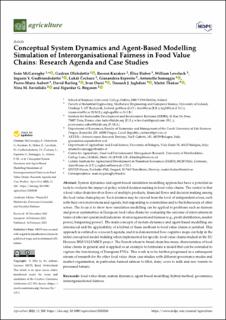| dc.contributor.author | McGarraghy, Seán | |
| dc.contributor.author | Olafsdottir, Gudrun | |
| dc.contributor.author | Kazakov, Rossen | |
| dc.contributor.author | Huber, Élise | |
| dc.contributor.author | Loveluck, William | |
| dc.contributor.author | Gudbrandsdottir, Ingunn Y. | |
| dc.contributor.author | Čechura, Lukáš | |
| dc.contributor.author | Esposito, Gianandrea | |
| dc.contributor.author | Samoggia, Antonella | |
| dc.contributor.author | Aubert, Pierre-Marie | |
| dc.contributor.author | Barling, David | |
| dc.contributor.author | Ðurić, Ivan | |
| dc.contributor.author | Jaghdani, Tinoush J. | |
| dc.contributor.author | Thakur, Maitri | |
| dc.contributor.author | Saviolidis, Nína M. | |
| dc.contributor.author | Bogason, Sigurdur G. | |
| dc.date.accessioned | 2022-08-11T10:57:55Z | |
| dc.date.available | 2022-08-11T10:57:55Z | |
| dc.date.created | 2022-04-29T12:34:12Z | |
| dc.date.issued | 2022 | |
| dc.identifier.citation | Agriculture. 2022, 12 (2), 1-30. | en_US |
| dc.identifier.issn | 2077-0472 | |
| dc.identifier.uri | https://hdl.handle.net/11250/3011262 | |
| dc.description.abstract | System dynamics and agent-based simulation modelling approaches have a potential as tools to evaluate the impact of policy related decision making in food value chains. The context is that a food value chain involves flows of multiple products, financial flows and decision making among the food value chain players. Each decision may be viewed from the level of independent actors, each with their own motivations and agenda, but responding to externalities and to the behaviours of other actors. The focus is to show how simulation modelling can be applied to problems such as fairness and power asymmetries in European food value chains by evaluating the outcome of interventions in terms of relevant operational indicators of interorganisational fairness (e.g., profit distribution, market power, bargaining power). The main concepts of system dynamics and agent-based modelling are introduced and the applicability of a hybrid of these methods to food value chains is justified. This approach is outlined as a research agenda, and it is demonstrated how cognitive maps can help in the initial conceptual model building when implemented for specific food value chains studied in the EU Horizon 2020 VALUMICS project. The French wheat to bread chain has many characteristics of food value chains in general and is applied as an example to formulate a model that can be extended to capture the functioning of European FVCs. This work is to be further progressed in a subsequent stream of research for the other food value chain case studies with different governance modes and market organisation, in particular, farmed salmon to fillet, dairy cows to milk and raw tomato to processed tomato. | en_US |
| dc.language.iso | eng | en_US |
| dc.publisher | MDPI | en_US |
| dc.rights | Navngivelse 4.0 Internasjonal | * |
| dc.rights.uri | http://creativecommons.org/licenses/by/4.0/deed.no | * |
| dc.subject | interorganisational fairness | en_US |
| dc.subject | governance; | en_US |
| dc.subject | hybrid method; | en_US |
| dc.subject | agent-based modelling; | en_US |
| dc.subject | system dynamics; | en_US |
| dc.subject | food value chain; | en_US |
| dc.title | Conceptual System Dynamics and Agent-Based Modelling Simulation of Interorganisational Fairness in Food Value Chains: Research Agenda and Case Studies | en_US |
| dc.title.alternative | Conceptual System Dynamics and Agent-Based Modelling Simulation of Interorganisational Fairness in Food Value Chains: Research Agenda and Case Studies | en_US |
| dc.type | Peer reviewed | en_US |
| dc.type | Journal article | en_US |
| dc.description.version | publishedVersion | en_US |
| dc.rights.holder | Copyright: © 2022 by the authors. Licensee MDPI, Basel, Switzerland. This article is an open access article distributed under the terms and conditions of the Creative Commons Attribution (CC BY) license (https:// creativecommons.org/licenses/by/ 4.0/). | en_US |
| dc.source.pagenumber | 1-30 | en_US |
| dc.source.volume | 12 | en_US |
| dc.source.journal | Agriculture | en_US |
| dc.source.issue | 2 | en_US |
| dc.identifier.doi | 10.3390/agriculture12020280 | |
| dc.identifier.cristin | 2020108 | |
| dc.relation.project | EC/H2020 727243 | en_US |
| cristin.ispublished | true | |
| cristin.fulltext | original | |
| cristin.qualitycode | 1 | |

